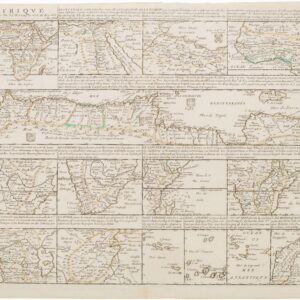Fantastic Bird’s-Eye-View of the Theatre of the Anglo-Egyptian War of 1882, compiled by one of the Victorian Era’s best view-makers.
Stannard and Son’s Perspective View of the Seat of War in Egypt.
Out of stock
Description
This is Alfred Concanen’s view of Upper Egypt, published by Victorian mapmaker William Thomas Stannard, known for his dramatic bird’s-eye-views of active armed conflicts. Here, we are provided with a vista of the theatre of the Anglo-Egyptian War of 1882. The folding map gives an excellent overview of the Delta region, where most of the battles of this war were fought. Below, we outline the reasons for the war, the significant events of the conflict, and its outcome.
The Anglo-Egyptian War of 1882: Establishing British Dominance in Egypt
The British conquest of Egypt in 1882 was a pivotal event that occurred amid a backdrop of political turmoil and shifting geo-strategic interests. The conflict would leave a lasting impact on the region and shape the political conditions leading up to WWI.
In 1882, Egypt was in a state of turmoil. Ahmed Urabi, an Egyptian army officer, led a mutiny against Khedive Tewfik Pasha, the ruler of Egypt and Sudan. Urabi’s grievances included pay disparities between Egyptians and Europeans and other concerns about the government. In response, the British and French governments issued a “Joint Note” in January 1882, expressing support for Khedive Tewfik’s authority. Tensions escalated when an anti-Christian riot in Alexandria led to the death of fifty Europeans. Urabi’s forces fortified the city, and the French fleet was recalled. A British ultimatum was rejected, and on July 11, British warships bombarded Alexandria, marking the formal beginning of the war.
Reasons for the Invasion
The reasons behind the British invasion of Egypt have been a topic of lengthy historical debates. Some argue that the invasion aimed to quell the Urabi Revolt and protect British interests, notably the Suez Canal, which was vital for maintaining the shipping route to the Indian Ocean. Others suggest that British Prime Minister William Gladstone’s government was motivated by safeguarding the interests of British bondholders with investments in Egypt. The close ties between the British government and the economic sector and a desire for a militant foreign policy undoubtedly played a role as well.
Key events of the war
The British fleet bombarded Alexandria from July 11 to 13, 1882, before occupying the city with marines. While the British did not lose any ships, much of the city was destroyed by fires and artillery shells and resistance by Urabi’s supporters. Urabi obtained a fatwa from the sheiks of Al Azhar, condemning Tewfik as a traitor and subsequently declaring war on the United Kingdom. The British Army, led by Lieutenant General Sir Garnet Wolseley, launched a probing attack at Kafr el Dawwar but determined it was impossible to reach Cairo by that route due to the solid Egyptian defenses. In August, a British army of over 40,000 invaded the Suez Canal Zone to destroy Urabi’s forces. This led to the Battle of Kafr El Dawwar on August 5, 1882. The primary battle nevertheless occurred on September 13, when the Brits attacked Urabi’s fortified position at Tell el Kebir. Here, the British forces achieved a decisive victory with minimal casualties, leading to the capture of Cairo.
In addition to sealing the fate of Egypt in the coming decades, the Anglo-Egyptian War saw the introduction of new tactical approaches that soon would become standard for European armies. Among the innovations were using railways to transport troops and supplies, telegraph communication to coordinate forces, and creating an Army Post Office Corps to provide postal services to men in the field.
Aftermath
After the British had won the war, Prime Minister Gladstone initially sought to put Urabi on trial and execute him, but the British prosecutor lacked strong evidence. Urabi’s charges were thus downgraded, and he was exiled.
After 1882, British troops continued to occupy Egypt until the Anglo-Egyptian Treaties of 1922 and 1936, which gradually restored control to the Egyptian government—this prolonged occupation aimed to safeguard British interests and investments in Egypt.
Cartographer(s):
Condition Description
Minor wear.
References

![[With Extensive Contemporary Annotations] Ordnance Survey of the Peninsula of Sinai Made in 1868-9 By Captains C.W. Wilson, and H.S. Palmer, R.E. Under The Direction of Major-General Sir Henry James, R.E. F.R.S. &c. Director of the Ordnance Survey](https://neatlinemaps.com/wp-content/uploads/2020/05/NL-00842_Thumbnail-300x300.jpg)
![[With Extensive Contemporary Annotations] Ordnance Survey of the Peninsula of Sinai Made in 1868-9 By Captains C.W. Wilson, and H.S. Palmer, R.E. Under The Direction of Major-General Sir Henry James, R.E. F.R.S. &c. Director of the Ordnance Survey](https://neatlinemaps.com/wp-content/uploads/2020/05/NL-00842-scaled-300x300.jpg)

![[Title on Verso] Tabula Prima Aphricae Continent Mauritania Tingitanam, & Mauritaniam Caesariensem](https://neatlinemaps.com/wp-content/uploads/2019/09/NL-00293_Thumbnail-300x300.jpg)
![[Title on Verso] Tabula Prima Aphricae Continent Mauritania Tingitanam, & Mauritaniam Caesariensem](https://neatlinemaps.com/wp-content/uploads/2019/09/NL-00293_r-scaled-300x300.jpg)